The flavor is perfect. Review over.
Jesse K: Boo! Hope I didn’t spook you too much, but I make no apologies, because we’re back in Innistrad now. I am thrilled. A long-awaited (maybe not that long-awaited) return to one of Magic’s most beloved planes, remembered for its excellent flavor, powerful cards, and top-notch limited format. What could go wrong?
Jesse T: The first time we visited Innistrad, it was in the fall. Just in time for Halloween, we were introduced to a host of vampires, werewolves, and zombies from the darkest corners of the gothic horror genre. This year, just in time for Easter, we have all of those exact same things miraculously rising from the dead.
K: In all seriousness, the set looks great, and I’m excited that we finally get to review something that earns our enthusiasm. Today we’ll be looking at the mechanics, themes, and major players in the Shadows over Innistrad story and how they all work together to create the overall feel of the set.
T: It’s pretty tough to say anything bad about Innistrad, but we’ll do our best. There was certainly enough unused material from the first block to fill several supplemental products and core sets, so a return to the eldritch plane seemed inevitable. Does the horror go deeper than we ever imagined, or are we just digging up a shallow grave? Read on, if you dare!
Themes and Mechanics
Horror Tropes
K: Now showing at your local Innistrad Multiplex: 13 Ghosts, Poltergeist, Children of the Corn, and, apparently, Resident Evil 2. This is my favorite part of Innistrad as a plane. Apparently (and thankfully) we didn’t exhaust all of these the first time we were here, so there are plenty of top-down, highly flavorful, evocative cards on display. We’re clearly double dipping to some extent here, with our second attempt at ‘witch who curses you upon her death’ and ‘mad scientist experiments with lightning’, for example. This makes me sort of sad, since it means we may in fact be running out of Innistrad material, and it’s a shame to think of leaving this plane behind for good, having mined it of all it’s natural horror movie resources. The return set manages to put a bit of a twist on these themes by erring more on the side of the horror-mystery and Lovecraft sub-genres. There’s definitely some B-grade material as well, which makes the set a funny combination of home runs (the blob), base-hits (shard of broken glass), and walks (star-nosed mole). Thankfully, there are few outright strikeouts (ghost… that works at a pharmacy?). Why have I fallen into a pit of baseball metaphors? I guess someone will just have to investigate my madness.
T: You barely dugout of that one. Innistrad has such rich, full-bodied flavor that you can essentially take any random handful of cards (as depicted above) and find more evocative designs than anything we’ve seen in the past year or so. Some of the names alone are enough to set the stage, like Just the Wind, Startled Awake, and Behold the Beyond. The set itself is even named after a Lovecraft anthology! There’s actually a fun game you can play: See how many complete sentences you can make using only the names of cards in this set. Incorrigible Youths Hope Against Hope From Under the Floorboards. Pieces of the Puzzle Survive the Night Ever After. Fevered Visions Rise from the Tides To the Slaughter. I don’t know whose idea it was to start naming cards after prepositional phrases, but thank you. Try it out! Aim High! Harness the Storm!
Double-Faced Cards
K: Transformation is such a prevalent horror trope that it was an absolutely brilliant move to nail down the way to capture it within the game for this block. Double-faced cards are kind of a hassle rules and gameplay wise, but boy oh boy is the flavor worth it. Most of the set’s biggest winners come from here, and it’s easy to see why. Each double-faced card tells a little story: The foolhardy ship brings something in the ice back to the port, and an unspeakable horror is loosed upon the town; A kindly stranger turns out to be a demonic witch; A Thraben Gargoyle comes alive, and evil can’t survive. The way werewolves transform is another little triumph. While it’s not a perfect match for the usual full-moon requirement, it feels cyclical and only partially in your own control. The in-game feel of these cards was always great in the original set, and they were well worth the baggage. It looks like more of the same here.
T: The double-faced cards are easily some of the best in the set. Even a random no-account common werewolf like Hinterland Logger tells its own self-contained story. In fact, I think if you count the front and back of the card, Hinterland Logger may have more lines of text written about her in existence than Arlinn Kord does.
Tribal
K: Horror tropes also mean monsters. We’ve got all your Universal classics: Zombies, werewolves, ghosts, vampires, plus the greatest monster of all, humans. The tribal support doesn’t seem tremendously deep, but the cards are all strong. There are enough shoddy excuses here to put together a tribal deck for sure, which is, for me, its own reward.
T: I’m pleased to see they finally printed that vampire-werewolf hybrid card we’ve all been waiting for. Now Team Jacob and Team Edward can put their petty differences aside and feast on human blood together. The Vildin-Pack werewolves are pictured here demonstrating their signature hunting technique where they all leap into the air at the same time and flap their arms around to confuse their prey.
Madness Returns
K: All the way back in Torment, when this mechanic debuted, it was used as a signifier of a world going crazy (at the time, Dominaria, thanks to Chainer, Dementia Master and his nightmares). As such, madness is a perfect mechanical match for Innistrad. Like double-faced cards it’s a lot more complex to implement in the rules than it is to play with, and also like them, I feel like the unique gameplay feel is worth it. Madness cards are in Grixis colors, which makes sense flavor-wise. It really feels like the mechanics they’ve chosen are a good representation of the plane.
T: Madness totally makes sense here. Not only is it a major theme of the block that interacts well with the graveyard, but we’re right in the midst of March Madness. The winning team, as always, will be invited to participate in an ancient victory ceremony held in the Foreboding Ruins beneath Markov Manor. Congratulations to all the good people playing whatever sport it is, and my deepest condolences to their loved ones!
Delirium
K: Delirium is a different way to pronounce Threshold. You achieve it by putting a bunch of cards in your graveyard. It sorta serves the same role as flashback did in the original set of creating a feel of managing or using the graveyard, which is naturally a spooky thing to do. Flavorfully, I guess the justification is that by the time you’ve got 4 different kinds of cards in the graveyard, you’ve just lost so much, so you go crazy. It’s most remarkable to me that the angel’s turning on them was enough to send the denizens of the plane over the edge, since everything else here is sort of already an endless waking nightmare. Delirium serves its role fine, and feels like a good match for the flavor of the plane.
T: Why would they put delirium in the same set as madness? Are they trying to see how many synonyms for insanity it takes before you actually lose your mind trying to remember which is which? Maybe they should throw in frenzy for good measure. This mechanic plays well with Tarmogoyf, and is just as flavorful.
K: One weird thing that can sometimes happen is if a creature with madness is discarded, it’s going into play, not the graveyard, where it can contribute to your delirium. So somehow madness is staving off the delirium. I’m not sure if this is a flavor-win or a flavor-fail, so let’s just call it even.
Clues and Investigations
K: Up until now, everything in the set has been a returning mechanic, albeit a well-selected one. Clues are this set’s flavor innovation, the only real new thing here at all. Thankfully, it really holds up. We rarely get to see non-creature tokens (gold and landmines only so far), so there’s plenty of design space. The conceptualization of these extra cards as ‘clues’ that you have to invest mana in is really great and does a lot of the leg work of making the set feel like a mystery. Plus you get to include lines of text on cards like “Whenever a creature dies, investigate.” Of course I’m going to investigate that! It’s hard to say now how it’s going to play, but I think it’ll give limited a really unique flow.
T: So far Innistrad is a fantasy-horror-mystery setting. All we need is romance and “young adult” and we’ve got ourselves a whole library! Shuffle your library. I miss books. Ever since Avacyn burned down the library in a fit of misguided rage there’s nothing to do with our time except solemnly contemplate the existential void. Yet another reason that investigating is so popular. I will say I’m a little disappointed that there’s no card clearly modeled after Sherlock Holmes or the Hounds of the Baskervilles or something, but the flavor basically delivers on all levels.
K: I guess Jace with a cool coat and Hound of the Farbogs don’t do it for you, huh? I also really like the way clues interact with the werewolf mechanic, which is probably accidental. Still though, think about it this way, the clues want you to hold mana up so you can spend it on your clues, but werewolves need spells to be played or else they flip on you. You’re literally too busy being pursued by werewolves to investigate the mystery. Beautiful!
Skulk
K: Is also a mechanic that is introduced in the set Shadows over Innistrad. It’s like an evasion ability with a slightly spookier than average name, because blue and black definitely were in need of more ways to make creatures hard to block. Let’s move on.
T: I read the flavor text, but I still don’t get what a homunculus is. Is it the same thing as 90% of college graduates?
Characters
K: The crux of the set’s story revolves around Avacyn going full-on inquisition on the people of Innistrad she was created to protect. What better way to represent her flipping her lid than with a flip card? I like this story beat; she was always kinda creepy, with her goth makeup and vampire-created pedigree, so it makes sense that it didn’t take much to push her over the edge. It helps that the line between religious missionaries and extremist zealots is so thin to begin with. Of course in the story she’s clearly been corrupted or manipulated by some outside force, but an explanation is barely needed here to be honest. The card art is great here too, with the very tip of her spear beginning to fracture on the front side of the card. I also like that her base form is a Serra Angel with upside.
T: I opened a misprinted copy of this at the prerelease with Akroma, Angel of Fury on the back and nobody noticed. Look, I get it. Being an archangel is a stressful job. Nobody expects you to be perfect, but there has to be some middle-ground between “can’t save everyone” and “might as well kill everyone myself”. The Hanweir Chronicle may be a shameless left-wing rag, but I do agree with them on one point: Avacyn needs to stop murdering everyone so much. Maybe she just needs a hobby. Has she tried Hearthstone?
K: As a subscriber to the Stensia Journal, I’ll inform you that the science is still out on whether or not Avacyn-change is caused by humans or just part of a natural cycle.
K: Hey, it’s Odric, that guy. No, not from original Innistrad, from M14. We forgive you if you forgot about him. He retains enough of his mechanical identity that this card feels like a natural extension of his character and not a random hodge-podge. This is a cool legend and invites some interesting build-around challenges. I like that by himself he does nothing, instead spreading the powers of his army around. Flavor nerds please note that he can confer up to 13 abilities.
T: Odric seems to be modeled after some combination of Vincent Price and Bride of Frankenstein. He’s been promoted from Master Tactician to Lunarch Marshall, which is really just a nice way of saying he’s been put out to pasture at a cushy desk job. Odric can be seen gazing longingly at his sword, remembering a time when it was used for something besides opening letters and beheading interns.
K: Jace is baaaack! That’s right, it’s another adventure with everyone’s favorite straight white male planeswalker between the ages of 18-30. This time he’s investigating the mysteries of Innistrad, unraveling its secrets, if you will. What is the demographically relevant source of the strange changes on the plane? Is it misandry again? A comic book movie that doesn’t capture the “spirit of the characters”? Or is it actually about ethics in video game journalism? Just kidding, it’s Eldrazi again. Probably. Look, I don’t necessarily hate Jace, it’s just that they have such a deep bench of planeswalkers that they could be calling in here to headline a block. What about Dack Fayden? He’s straight, white, and male too, and he’s also the greatest thief in the multiverse. I can see him in the Sherlock Holmes role here for sure. . . What do you think of another double serving worth of Jace, Jesse T?
T: They just keep bringing Jace back for some reason, and it’s not cool. It’s Emrakul.
K: Here’s our most interesting planeswalker, mechanically speaking. By making her a werewolf walker, she gets to have different abilities in each of her incarnations. I have a hard time imagining her getting to that ultimate in most games, since the most reasonable path to it looks like it’ll involve mini-overrunning for several turns in a row. I don’t have much to say about Arlinn because I don’t really get a sense of her place in the story here. She seems like a good guy, but I’m basing that on the art.
T: Julianne Moore stars as Arlinn Kord, whose lycanthropy is a metaphor for society’s fear of womanhood. Following in the tradition of Ginger Snaps and When Animals Dream, Arlinn was taught to be ashamed of her animal instincts until it became clear that society (here represented by a genocidal angel in clown-white foundation) is the real monster. If you’re interested to know more about Arlinn, too bad. Enjoy another dozen installments of Uncharted Realms about Jace instead.
K: It’s a giant, man-eating (and land-eating) toad monster that is worshipped by the superstitious people of Innistrad. That’s it, just a giant frog. This thing has no motivations, no backstory, and no story importance, and I find it about a million times more compelling than Jace mk. 9. I love this character, and am happy to see a legendary monster instead of the usual human cast of characters. To me the ideal conclusion of this block is that Jace gets pushed into a bog and eaten by this thing.
T: When fighting the Gitrog Monster, it’s important to watch his attack patterns and time your movements correctly. When he stops jumping, run to the other side of the screen and wait for him to attack with his tongue, exposing his vitals. Then just spam melee attacks until he starts jumping again. After you hit him 10 times or so, he drops the Drownyard Key, which you can then trade to Ludevic for a pair of Google glasses.
K: Nahiri is the antagonist behind that scenes of the current chaos in Innistrad. Once she worked alongside Sorin and Ugin to seal away the Eldrazi on Innistrad. If you’re looking someone to blame for the overabundance of hedrons, this is your target. Nahiri won’t rest until every plane is covered with ubiquitous visual elements made of stone, and has been dotting the landscape with something they’re calling cryptoliths. She appears to be either doing the bidding, or at least summoning some kind, of greater evil, in the name of seeking revenge on Sorin and his home turf. Maybe some kind of payback for the mediocrity of BFZ Block. Lithomancy is a cool power, and one we haven’t seen much of, but I don’t know if her abilities really communicate that to me. I do love the art on this card and it feels like a unique and eclectic combination of abilities.
T: Cryptoliths, literally “mystery rocks”, are depicted throughout the set as vaguely bird-shaped objects instead of something with aesthetic or creative value. These 3-D Rorschach tests raise many questions: What are they for? Where did they come from? Is getting Nahiri to ulimate any better than just playing Through the Breach? The answers almost certainly involve summoning Emrakul. Nahiri doesn’t really do much for the setting, since she isn’t a ghost or mummy or anything, but it is nice to have a second female planeswalker in the mix.
K: It looks like the conflict on Innistrad already has a few casualties in Olivia’s sense of style and mysterious third leg. I guess I’m fine with this card, and relieved that this version of her is nowhere near as annoying to play against as the original. Still, something makes me not quite as excited to see Olivia again. Maybe I’d be more compelled with the storyline of “formerly evil vampiress now fighting a greater evil” if it hadn’t literally just happened one set ago.
T: Olivia’s “mobilization” has mostly been for show. She puts on her fancy armor, and flies around Stensia asking people to come to opulent fundraising galas, but she’s completely out of touch with the needs of the people of Innistrad. She barely even tries to hide the fact that she views them as food. Sigarda is a much better candidate, in my opinion. She’s consistently opposed the extermination of all humans from the beginning, and she has the voting record to back it up. Feel the bird!
K: Sigarda’s our hero now, the only angel of the AVR trio willing to stand up to Avacyn now that she’s gone all blood-lust-y. You can tell that she’s selfless because she’s given up her previous career of being a good card in order to protect you and other humans. I get that you’d want her ability to make humans, but what exactly does exiling cards from a graveyard represent here? Is she making dead zombies and werewolves back into people? Is she an ingester? One thing that’s cool about this ability is that it cures your delirium, so maybe that’s what they’re going for.
T: Even angels have to stand up to peer pressure. “Come on, Sigarda. Destroy all humans. You know you want to. All the cool archangels are doing it.” It isn’t always easy, but Sigarda’s will is strong. Her symbol, the heron, is one of hope and integrity in troubled times, so someone ought to tell her it looks exactly like those freaky cryptolith things. She’s gonna want to distance herself from that whole semiotic quagmire before people start asking questions. “Is your staff a cryptolith? What is a cryptolith? Is it the same as a homunculus?”
K: Sorin’s madder and more poorly illustrated than ever in his latest incarnation. He’s so mad cause Nahiri wrecked up his house and strewed vampires all over the place. Remodeling is going to be a nightmare, perhaps literally since this is Innistrad. I’m glad that this card takes Sorin in a different direction, since two black-white versions with nearly identical abilities was already too much. I think his ultimate is especially flavorful (and it better be, since you’re never actually going to use it), as he just summons enough vampire minions to ice the whole table.
T: Because white hair is the coolest thing imaginable, both Nahiri and Sorin appear in this set together. I’m looking forward to the tribal demon subtheme in Eldritch Moon where Dante from Devil May Cry, the guy with cat ears from Inuyasha, and most of the GOP join the battle. It’s great when a planeswalker’s abilities make sense together, and in that regard, Sorin is the best of the bunch. While it’s questionable whether Nahiri’s abilities have anything at all to do with earth or stone magic, Sorin is clearly quite interested draining away your life points.
K: And this is an inanimate object that I find more compelling than Jace. Okay, okay, enough grousing about Jace. Tamiyo is in this block too! Just not yet. Instead we’ve got the framing device of her journal leading our characters on a magical mystery tour. It’s interesting that one of the major sources of flavor text in this set is actually a card in it, which opens the door for all sorts of interesting designs. What kind of powers would a copy of The Theriad grant you, for instance? What about The Love Song of Night and Day? 101 Great Quips About Fire, by Jaya Ballard? The list goes on and on.
T: Tamiyo, fascinated by the many loligoth subcultures of the multiverse, left her home plane of Kamigawa to study with the astronomancers and scienceomancers of Innistrad. Her journal details her findings about Innistrad’s moon, among other things. Leading theories in the field posit that it is either A.) a demon’s eyeball, B.) a giant heron egg, or C.) a mild dessert cheese. Will Jace be able to unravel the mysteries of this cryptic tome before the plane, and everyone on it, is destroyed? Of course he will! That guy just won’t ever go away.
K: I’m gonna note that Ormendahl doesn’t make you sacrifice the Arby’s, nor does he simply come out of it since it’s no longer there after you use the ability. The only flavor conclusion I can reasonably come to is that the building actually becomes a demon prince, transformers style. Now that demons on Innistrad pop out of swords, helvaults, and abbeys, you have to wonder what’s left. Careful with that censer, George Clooney, you never know what’s going to be a demonic horcrux on this plane.
T: Ormendahl is the spiritual successor to Griselbrand‘s legacy of demonic troublemaking, but it looks like Avacyn’s really beaten him to the punch on all fronts. What do you do when you escape from imprisonment to wreak havoc on the righteous, only to find all of it already wroke? Does he team up with Sigarda now? Go back to sleep? Flay some abbots? Maybe he should check out Hearthstone…
Final Thoughts
T: This is definitely a good time to be playing Magic. With all the madness and mystery, Shadows over Innistrad definitely lives up to the hype of its predecessor, which is no small task. From the fake newspaper and cryptic mailings that heralded its arrival, to the actual gameplay of the cards themselves, the set is lovingly detailed and completely immersive. I can’t wait to see what new developments Eldritch Moon brings. Besides Eldrazi. If you don’t see those tentacles coming from a mile away, you need to make like investigate and get a clue.
You can find Two Jesses on Twitter @TwoJesses.



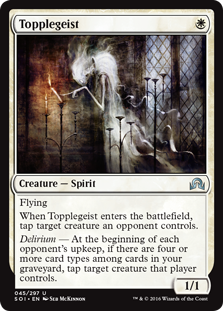








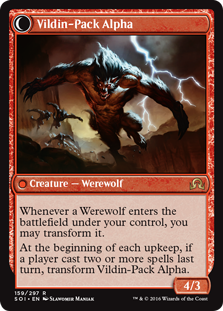
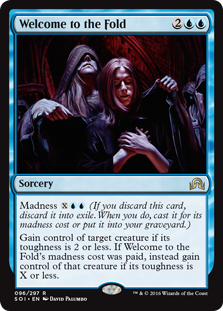
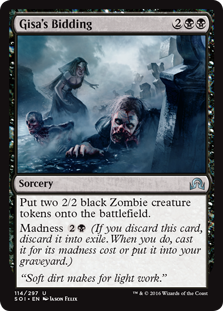

















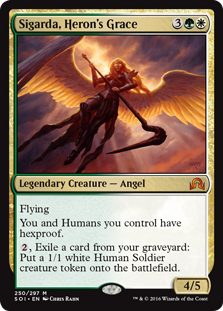

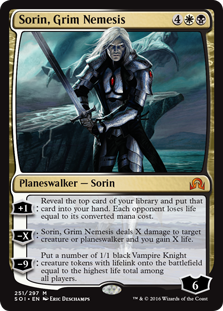
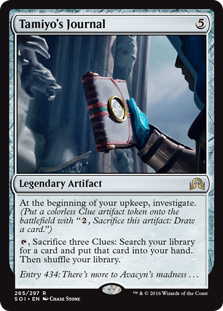
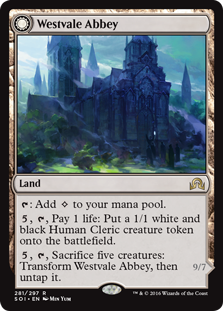
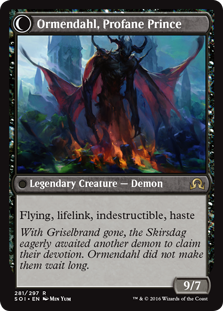
The thing really keeping me from liking the Gitrog Monster is that in the Uncharted Realms about it, its powers are revealed to be literally actually Hypnotoad from Futurama. The last thing a horror story needs is a punchline referencing a cartoon.
Madness staving off delirium has been my prime psychological goal for decades now.